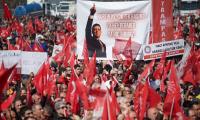The writer is the author of 'Governing the ungovernable'.
What are the possible remedial measures to subdue inflationary pressures in the economy? None of them is a quick fix or short-termish but requires patient and consistent action immediately to produce results in the medium and long term.
It is quite understandable that political compulsions necessitate attention to be focused on short-term problems, but the downside is that the essential long-term policy decisions are neglected. Urgent takes precedence over important. The main thrust for combating inflation has to be expansion of domestic productive capacity and keeping it aligned with growth in aggregate demand. Productivity levels in both farm and non-farm sectors are stagnating and low compared to our neighbouring countries and have to be raised. The means to do so are well known and have been spelled out ad-nauseum. We outline below some of the measures that would help subdue the inflationary pressures but – and let me stress this --not right away.
First, public policymakers should pay more attention to resolving supply bottlenecks and encourage efficient import substitution. Thar coal is much cheaper than imported coal and therefore the existing plants should be reconfigured to use domestic coal as fuel. Gasification of coal is another possibility that needs to be explored for substituting natural gas for producing power. Renewable energy projects such as hydel, wind and solar ought to be given priority for completion. Investment in transmission and distribution gaps to enable the switch from imported fuels to indigenous should be undertaken expeditiously.
The government’s decision to introduce a competitive market model with multiple buyers and sellers is highly welcome but the pending issue of wheeling charges has yet to be resolved. DISCOs are already on the agenda of the Privatization Commission for management contracts and action is required to bring the process to the end point. Exploration and development of energy reservoirs in Balochistan should be stepped up. Retail sales of gas companies should be opened up to the private sector through a transparent competitive process.
Weighted average cost of gas formula has become a victim of political bickering, without realisation of how much damage it is doing in the fast depletion of our natural gas resources. The two private terminals for RLNG ought to be made operational as early as possible. The oil refinery policy has been debated for so long and should be operationalised. The energy ministry, although perpetually under severe pressure, should resist the temptation of running things from Islamabad and allow the companies under its control operational autonomy while holding them accountable for results. They get unnecessary blame for everything that goes wrong in the sector.
With the completion of the National Social and Economic Registry, it is now possible to move away from the present system of across-the-board subsidies on wheat, electricity, fertilizer, seeds etc to a system of targeted subsidies. Not only is it a fiscally responsible measure that would result in savings on public expenditures it will also help smooth consumption and enhance productivity of deserving households. The impact of these targeted subsidies in the farm sector for promoting production of oilseeds, pulses, and other commodities short in supply could be significant.
Third, export growth particularly in new sectors of the economy should be possible now with a remunerative exchange rate but careful planning has to be done for each sector to identify the specific constraints faced by the exporters. It is not realised that in a world dominated by global value chains, tariffs on imports of components and intermediate inputs act as a tax on exports. There has been some positive development in the last few years on IT exports. The scope for further expansion is quite large and the government should keep its hands off this sector and adopt a ‘do no harm’ policy only removing the impediments from their way.
The National Tariff Commission has been given the responsibility of setting tariff policy because the FBR was too obsessed with revenue maximisation rather than promoting industrialisation. The NTC ought to take into consideration the factors that would make Pakistani exports competitive in the world markets. The largest market in the world – China – has not been fully tapped, despite our close relationship. The aim should be to attain a sustainable position where exports of goods and services can finance up to 80 percent of imports – reducing the quantum of trade imbalance, alleviating the stress on current account and dependence on external borrowing. A National Single Window would, hopefully, be able to reduce the costs of international trade transactions and increase the returns to the exporters.
The government’s direct and indirect intervention in the functioning of output and factor markets has become too intrusive. Price setting, administrative controls, compulsory procurement, releases and allocations have distorted markets and the results are contrary to the government's desire to stabilise prices. Hoarding and black marketing create shortages despite the efforts of local administration. Information flows about the quantities of goods entering and leaving the market are known only to the market players and are not known to the administrators. On the contrary, their interference creates disorderly conditions rather than stability. Except for reserve stock management for wheat and administering taxes and targeted subsidies, the government should refrain from intervening in the markets through administrative measures as they're counterproductive.
Finally – and this is the moot point which is hardly discussed in our discourse on economic policies – current account is an accounting identity where savings equal investment. If domestic savings fall short of the investment requirements, the gap is filled by foreign savings. Our neighbouring countries were in the same position with low savings and low investment rates. They have almost doubled both domestic savings and investment rates over time, which explains their impressive growth rates and reduced dependence on foreign savings. They are in a comfortable position to finance their trade imbalances through non-debt creating external inflows such as foreign direct investment without resorting to extensive borrowing.
Domestic savings are a mixture of private household, corporate savings and public-sector savings. If the fiscal deficit is eight percent of GDP and state-owned enterprises have negative savings of two percent of GDP, the aggregate domestic savings rate would be lowered by 10 percent and our capacity to invest would be limited to the extent of our domestic savings supplemented by workers' remittances from overseas. Higher investment required for sustaining a high growth rate can only take place by foreign savings in the form of borrowing unless FDI pours in. This explains the genesis of our recurring external account difficulties. Therefore, containing fiscal deficit to a manageable level and restructuring and privatising SOEs are the policy options that have evaded us so far but are essential for keeping control of the current account and combating inflation.
To sum up, efficient import substitution particularly in food items, targeted subsidies, export competitiveness, minimising government controls on markets and reducing fiscal deficit are the remedial measures that would have beneficial impact on fiscal and current accounts, external borrowing needs and inflation in the medium term. Attention and action are required now, not later.
Concluded
Internationally, there have been misleading theories propounded about so-called slowing of Chinese economy
Karachi has long been Pakistan’s financial capital and a major hub for industry and trade
In the past, with every rising of the sun, much anticipation was associated with reading the newspaper
It is clear that more is at stake as US abandons its role as global leader of system based on multilateralism
I believe that those who adopt attitude of forgiveness, mercy and tolerance are role models for all of humanity
First major point of contention between Brussels and Washington is the unequal distribution of defence expenditure







